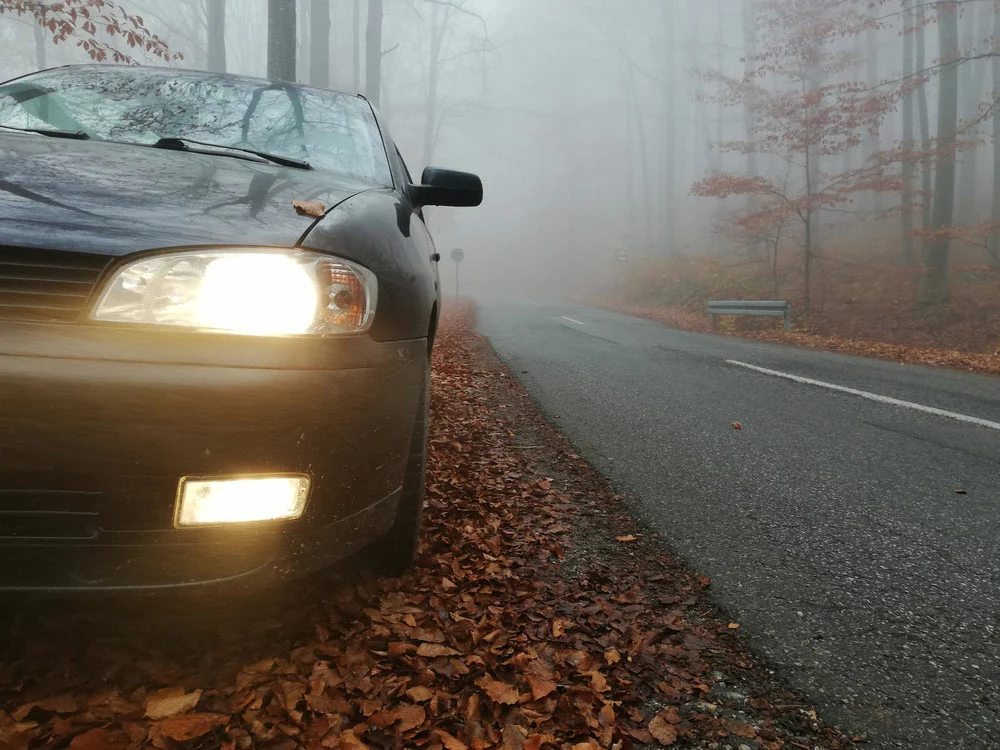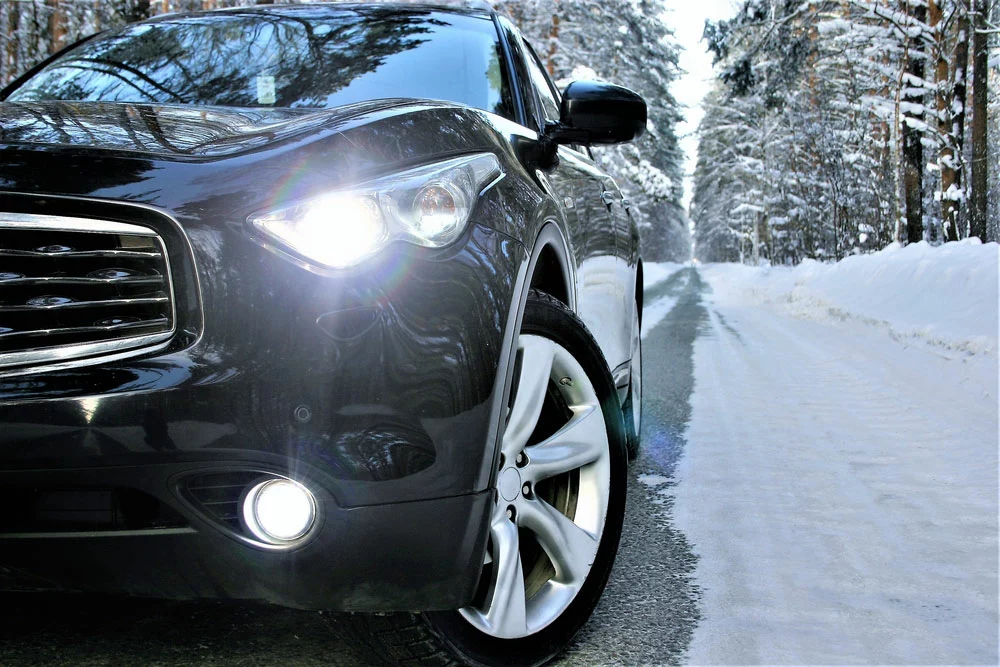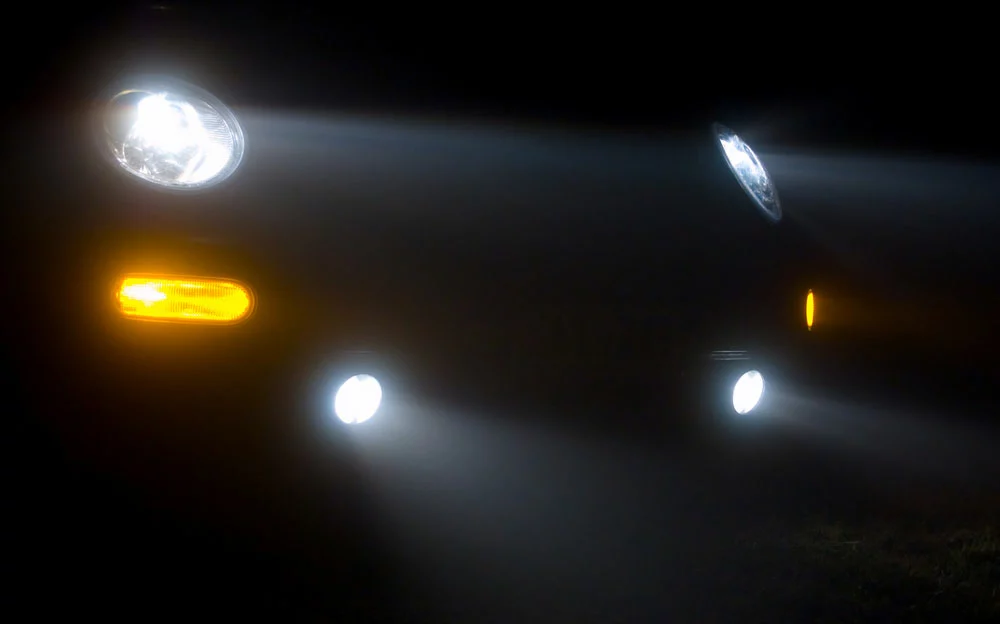About Headlights vs. Fog lights: Driving down a dark or barely visible road requires some light. However, the exact conditions determine the lights you need. For example, a regular night drive requires strong beam headlights, while bad weather conditions favor fog lights.
You can find these lighting types on various vehicles. And they each serve unique purposes. But the big question is: What are headlights and fog lights? And how are they different? You’ll understand what sets these two car lights apart in this article.
Are you ready? Let’s go!
What are Headlights?

White headlights
Headlights are a vehicle’s primary driving light located at the front. You can also call the low-beam lights or driving lights.
But that’s not all. Activating reflector headlights can be turned on for other necessary lighting systems like parking, rear tail, and license plate lights.
Usually, headlights stay on during darker conditions (dusk to dawn). These lights also offer enough illumination when visibility is below 200 to 500 feet–due to weather or other conditions. Similarly, some states impose that headlights should be on when using windshield wipers.
Types of Headlights
Generally, we have two headlight types: Low-beam and high-beam headlights.
High-beam Headlights
High-beam headlights offer high brightness levels that can illuminate 250-350 feet ahead. However, we don’t recommend turning them on when driving on two-way roads–especially with other drivers on the road.
Moreover, high beams work for trips on rural or dark roads with few street lights or traffic. But, you’ll have to swap to low-beam when close to an incoming car (usually 500 feet). Why? Well, high-beam headlights are bright enough to blind nearby drivers.
Low-beam Headlights
You can see up to 200 feet with low-beam headlights. That’s enough to spot signboards, cars, and pedestrians ahead of your vehicle.
Note: High beams don’t work well in foggy conditions. They would reduce visibility and generate glare for other drivers.
What are Fog lights?

Headlight and fog light
Unlike headlights, fog lights light up the road under the car. These lights will provide enough illumination in foggy conditions since fog gathers close to the ground. Interestingly, you can find fog lights under the front bumper.
Moreover, fog lights can illuminate immediate corners around the car or directly in front. They’re a great way to see the parts of the road headlamps won’t reach.
You can also find rear fog lights behind the car’s back bumper. These lights can show your vehicle’s position without overdoing it.
Headlights vs. Fog Lights: The Differences
Let’s look at the differences between headlights and fog lights.
Beam Patterns

Light beams from headlights
Headlights and fog lights have different beam patterns. Fog lights can emit low, wide beams that focus more on the ground. It enhances visibility in areas with a lot of moisture in the air (fog or mist).
In contrast, headlights cast long, high light beams that can illuminate long stretches of road. Although they won’t provide enough visibility for foggy or misty conditions, headlights are bright enough to make driving in low-light conditions easy.
Placement

Location of headlight and fog light
Placement is another factor that differentiates headlights and fog lights. As we mentioned, headlights occupy higher positions on the vehicle, while fog lights take lower locations. You can also find rear fog lights that offer enough illumination for indication.
Fog lights stay inside the car’s front body, which prevents them from shining upwards and generating glare for oncoming traffic.
Features

A woman installing fog lights
Headlights feature circular, long-range projection lights for front illumination. In contrast, fog lights feature rectangular, scattered, short-range light side and direct front illumination.
Fog lights also feature cut-off deflectors. This feature prevents the light from shining upwards, allowing only straight and downwards illumination.
Note: Rear fog lights don’t have cut-off deflectors
Color

White headlights and fog lights
Most vehicles feature white-colored headlights. But in contrast, fog lights can come in yellow, amber, or white.
Usage
You can use headlights during darker hours, typically sunset to sunrise. You can also use them in dark tunnels and driveways.
Contrarily, we recommend using fog lights only when the weather hinders your vision. Ensure you use headlights if the weather is clear.
How to Use a Car’s Fog Lights
You can turn on your fog lights from your car’s dashboard. A switch will usually allow you to activate or deactivate them. Most cars also have built-in settings, allowing you to turn on fog lights without activating your headlights.
However, it’s crucial to use your fog lights adequately when driving in foggy conditions. Ensure you only activate them when visibility is low. We recommend deactivating them when visibility enhances.
Are Fog Lights Perfect for Day Running Lights?
DRLs are automatic lights that run daily to enhance your car’s visibility. They can be parking lights or slim LEDs forming a frame around the headlight and taillight.
Although we don’t recommend using fog lights during the day, you can use them as a substitute for DRLs.
Likewise, DRLs can also serve as alternatives for malfunctioning or damaged fog lights. But it’s safer to have functioning fog lights for heavily foggy conditions.
FAQ
Are fog lights compulsory?
It depends on your region. For instance, in the U.S, many motorists see fog lights (front and rear) as auxiliary lights, making them optional.
When do fog lights become necessary to use in a car?
It would help if you had fog lights for weather conditions that reduce visibility. For example, it could be rain, dust, snow, or fog.
Are fog lights available on every car?
Not all cars feature fog lights. However, most newer vehicles combine them with headlights. You can get fog lights as an optional add-on or install them yourself.
Final Thoughts
Headlights and fog lights perform different functions on a vehicle. Also, you can’t interchange them, as doing so may lead to fatal accidents.
Headlights project long beams that cut through the darkness ahead of a vehicle. Contrarily, fog lights provide non-intrusive lighting for areas with low visibility.
Do you have any questions? Be sure to contact us, and we’ll be happy to help.
